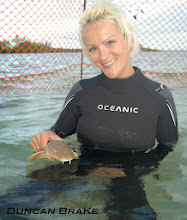Sunday, August 5, 2012
Shallow Water Sun Tans and Snacks: Lemon Sharks on the Hunt
The research done at the Bimini Biological Field Station (Sharklab) has found that juvenile lemon sharks use the shallow flats to hunt on low tides. Different research projects have used tracking and visual accounts to record hunting, feeding and social behaviors in the regions. Juvenile lemon sharks use the mangroves as a nursery; the shallow waters reduce the risk of large predators being present and also reduce the area that prey has to escape.
Duncan and I recently joined Sharklab director Dr. Tristan Guttridge to film and do observations from a tower erected in the shallows. We arrived as the tide was falling and watched as one, two and then up to ten juveniles moved around our viewing perch. As the tide dropped so did the size of the sharks making use of the area. Pups born this year were working the patches of sea grass looking for small fish and crabs. Amazing to see a wild shark detect possible prey and use electroreception, scent and sight to track it down.
We watched patiently for hours and recorded behaviors, keeping an eye out specifically for sharks that had transmitters on them. Duncan and I were hoping to capture a predation event on camera and four hours into our watch we lucked out. As closing time was fast approaching we watched as a lemon shark, most likely born in the spring, worked an area of sea grass right in front of us. His large circles quickly tightened and his movements became sharper. Whatever was hiding in the sea grass had peaked his interest and he seemed determined to make a meal of it. We watched, cheering on the shark to, “ get it, get it, “ when finally a small shape darted from its hiding spot and the shark snagged it. The small fish dangled briefly from the clenched jaws of the perfect miniature predator before disappearing for good. Exciting for us to capture on camera, but even more incredible to witness.
We see sharks feeding all the time, but either we are generating the prey source or someone else is. We watch the sharks eat, but we do not get to appreciate the finely tuned hunting skills that have been perfected over years of evolution. We give presentations and tours, explaining to people how shark senses work and what happens when they go in hunt mode. Watching it brings a whole new level of appreciation for just how awesome these animals are.
As we packed up the gear and climbed down from our perch, we left with an ever- increasing enthusiasm for these incredible ocean predators that we love and are endlessly in awe of. Witnessing these behaviors also enhances our resolve to help the mangrove areas that are absolutely vital for these juveniles. Without their protection and the opportunity to feed in the shallow areas surrounding them, adult lemon shark populations will suffer drastically as will the other species of fish, conch and lobster that rely on the mangroves. Bimini is working hard to protect its natural resources despite the best efforts of outside forces to destroy the natural environment in order to create an entertainment space for the rich travelers that cannot possibly travel to an island without a golf course or casino.
Hopefully the marine protected area that is in progress of being finalized will ensure that at least some of these tiny sharks will have an ecosystem to thrive in and return as adults to give birth to the next cohort. Check out the SHARKLAB and Bimini MPA for more information on how you can help the sharks of Bimini and the Bahamas.
Subscribe to:
Post Comments (Atom)








No comments:
Post a Comment